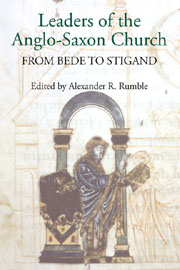Book contents
- Frontmatter
- Contents
- List of Illustrations
- Preface
- Contributors
- Abbreviations
- Introduction: Church Leadership and the Anglo-Saxons
- 1 Bede and the Early English Church
- 2 Archbishop Ecgberht and his Dialogus
- 3 Abbatial Responsibility as Spiritual Labour: Suckling from the Male Breast
- 4 Understanding the Earliest Bishops of Worcester c. 660–860
- 5 The Role of Bishops in Anglo-Saxon Succession Struggles, 955 × 978
- 6 Image-Making: Portraits of Anglo-Saxon Church Leaders
- 7 ‘To Keep Silence Following the Rule's Command’: Bishop Æthelwold, Reforming Ideology and Communication by Signs
- 8 Wulfsige of Sherborne's Reforming Text
- 9 From Winchester to Canterbury: Ælfheah and Stigand – Bishops, Archbishops and Victims
- Index
6 - Image-Making: Portraits of Anglo-Saxon Church Leaders
Published online by Cambridge University Press: 05 February 2013
- Frontmatter
- Contents
- List of Illustrations
- Preface
- Contributors
- Abbreviations
- Introduction: Church Leadership and the Anglo-Saxons
- 1 Bede and the Early English Church
- 2 Archbishop Ecgberht and his Dialogus
- 3 Abbatial Responsibility as Spiritual Labour: Suckling from the Male Breast
- 4 Understanding the Earliest Bishops of Worcester c. 660–860
- 5 The Role of Bishops in Anglo-Saxon Succession Struggles, 955 × 978
- 6 Image-Making: Portraits of Anglo-Saxon Church Leaders
- 7 ‘To Keep Silence Following the Rule's Command’: Bishop Æthelwold, Reforming Ideology and Communication by Signs
- 8 Wulfsige of Sherborne's Reforming Text
- 9 From Winchester to Canterbury: Ælfheah and Stigand – Bishops, Archbishops and Victims
- Index
Summary
WHEN I imagine St Cuthbert, I draw on two unrelated pictures. The first is of the hermit saint described in Bede's near-contemporary Historia Ecclesiastica and the Vitae of St Cuthbert. I thus see him as emaciated from a diet consisting, in his last days, entirely of raw onions; and in the boots which he wore day and night, only removing them for the Maundy footwashing ceremony at Easter, when the calluses from constant friction were revealed. I visualize him in simple undyed clothes, blending in with the wild seas and bleak landscape of my native Northumberland. The folk memory of the area softens the image slightly: legends of Cuthbert communing with seals, which still inhabit the waters around Lindisfarne, the familiar naming of the wild birds as ‘Cuddie ducks’, or ‘st Cuthbert's ducks’, and the local pronunciation of the place-name: not ‘Lindisfarne’ or, as the tourist would read it off the map, ‘Holy Island’, but ‘Holy Island’, which takes for granted the palpable sanctity the place still manifests.
My second image is of a kind of silken cocoon. The saint's body, possibly embalmed but increasingly desiccated and skeletal, came to be swathed in layer after layer of precious textile, Chinese and Byzantine silks: not, on the whole, tailored garments but rather lengths of cloth, with the glint of gold from the embroidered stole, maniple and girdle which King Æthelstan probably presented to Cuthbert's shrine.
- Type
- Chapter
- Information
- Leaders of the Anglo-Saxon ChurchFrom Bede to Stigand, pp. 109 - 128Publisher: Boydell & BrewerPrint publication year: 2012

